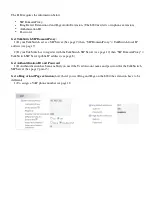
HTTP://GLOBAL.TALKSWITCH.COM
5
Select which TalkSwitch to use as the SIP network server
A multi-location SIP network requires a SIP server to manage calls across the
network. The SIP server contains registration information for all SIP devices in
the network. When making or receiving a VoIP call, a device will register with the
SIP server, which will then route the call to the appropriate destination.
TalkSwitch units have a built-in SIP server to manage a VoIP network. Though
every networked TalkSwitch unit has the capability, you must designate only
one
TalkSwitch unit in a network as the SIP server.
Note:
For VoIP calls made through a VoIP service provider, the service provider
will act as the SIP Server.
Which location and TalkSwitch system should I configure as the SIP server?
Any TalkSwitch unit on the network can be designed to be the SIP server.
To simplify network operation and reliability, we recommend that you choose a
location that has a
static
, rather than a
dynamic
public IP address. A static public
IP address does not change, providing a consistent connection address for each
location to communicate with the SIP server.
If you do not have a static IP address, you can obtain a Fully Qualified Domain
Name (FQDN) from a Dynamic Domain Name Service (DDNS) provider. A DDNS
matches your dynamic IP addresses to your FQDN, so that your TalkSwitch VoIP
network operation is not affected by IP address changes.
One DDNS provider is DynDNS; visit:
http://www.dyndns.org/services/dns/dyndns
for more information.
Configuring TalkSwitch to act as the SIP server is described in STEP 2 of this guide
—
Configure TalkSwitch to act as the SIP Server
.
Example:
Building on the previous example, the TalkSwitch system in the
London office is designated as the SIP server — see Figure 3. When a location
initiates a call, the TalkSwitch in London will resolve the destination address
for the call, and coordinate a connection to route the call to its destination.





















